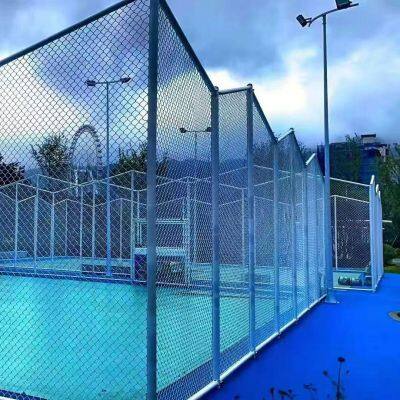-
 Liu
Hi there! Welcome to my shop. Let me know if you have any questions.
Liu
Hi there! Welcome to my shop. Let me know if you have any questions.
Your message has exceeded the limit.

Sport Court Fencing: Quality Solutions for Tennis Courts and Sports Facilities
2025-10-10 10:16:32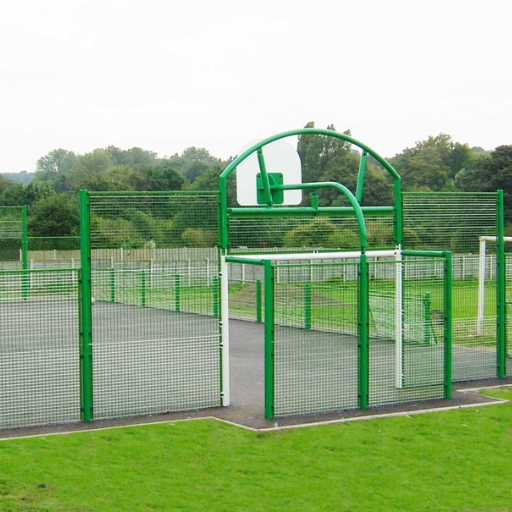
If you ever dream of building a perfect sports ground, you can’t deny that the smallest details count and among these is the installation of walls around the field; however, many sports enthusiasts tend to forget the importance of ensuring that good walls are put in place. It doesn’t matter if you are providing your customers with any type of sports court. The most suitable fencing option minimizes injuries, maximizes space utilization, and, at the same time, brings out the beauty of the ground. In this blog post, you will find out everything related to sport court fencing – features that will make you spend, and materials you will want to use. Be prepared since there will be insightful ideas about turning the sports courts into an attractive and functional fenced area.Find more info now.
Understanding Sport Court Fencing
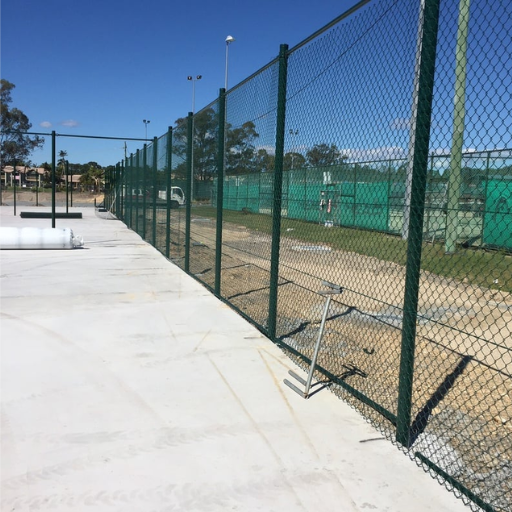
In addition to their fundamental function, sport court fencing may sometimes incorporate some extra features enhancing its usability. Good perimeter structures ought to possess curved walls, high walls, and the correct materials used. Standard fencing materials, such as mesh and chain-link, come strong and optically clear. More so, good fencing assists in enclosing the balls and the equipment limiting out of bounds and preventing any crossover. Appropriately selecting the fence even aids in maintaining a safer facility for individuals inside athletes and outside spectators.
What is Sport Court Fencing?
Barriers designed to enclose athletic fields safely are called sport court fencing. It provides safety, prevents vandalism of the equipment used, and allows easy viewing of matches. All these have been provided addressing each sport’s unique needs, requirements and standards.
Types of Sport Courts and Their Fencing Needs
Sport Court Type | Fencing Height | Material | Purpose | Additional Notes |
|---|---|---|---|---|
Baseball/Softball | Outfield: 4-6 feet | Chain link | Safety, ball containment | Backstop fencing is essential |
Tennis | 10 feet | Galvanized chain link | Ball containment, aesthetics | Horizontal rails improve durability |
Track Field | 4 feet | Powder-coated chain link | Safety, access control | Gates for athlete movement |
Football/Soccer | 4 feet or higher | Chain link or double wire | Impact resistance, access control | Durable for high-impact games |
Backyard Courts | 10 feet (public courts) | Black or green fencing | Privacy, ball containment | Minimalistic for residential areas |
The Importance of Quality Fencing in Sports
The importance of good fencing cannot be overstated as this guarantees safety, ensures proper functioning and protects recreational courts. In the presence of a good fence structure, not only the visitors and the users of the facilities are safe, better regard and performance in play surfaces is availed. In this way, the owners of the sports facilities can remedy these specific protruding dures by employing the installation of quality fencing. Below will be considered five main points explaining why good fencing is necessary in sports:
Safety Investment for Participants and Attendees
Resilient fencing, apart from being a very ideal pia as in separates zones, it also serves to curb injuries from occurrences like what Flowers overcame in the decking area. For example, in sports such as tennis or baseball, players or fans cannot be hurt by balls as the fence surrounding the court provides safety.
Prevention of Equipment Loss
In addition, they help safeguard gym or field facilities in a way that equipment like balls or other sport-related items can not exit the facility and disrupt play, bringing such danger. Particularly, they are seen in the cases of dynamic sports activity such as football or basketball, where the participants carry things outside the court.
Permission level
There are certain fencing standards that some sports organizations require their players to meet, especially during tournaments or competitions. The role of high protective fencing addresses these concerns by meeting the required standards and evading any sanctions that may come with use of the facility.
Enhanced Transparency and Aesthetic
With the use of quality materials for fencing, enclosed areas present transparent chain link fences or provide transparent panels which are very attractive. This aspect provides comfort to the audience and does not destroy the business décor of the place.
Long Life and Competitive Pricing
Fences must be sturdy and able to endure wear and tear for a long period of time while also being cost-effective in installation and long-lasting.
Spending money on strong fences is cost-efficient because it reduces monthly maintenance expenses. Heavy-duty fences, such as weather-resistant ones, are an example of heavy-duty fences. There are no worries about possible destruction or sport court fencing extension that may arise due to extreme outdoor temperatures.
Most indoor sport court owners have the propensity of securing these areas in contemplation of the safety of all persons as well as prospects for correction furnished by the courts in the future.
Components of a Sport Court Fence
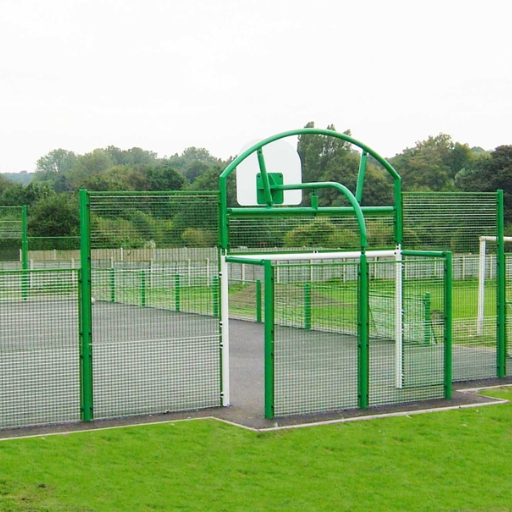
In order to design a sport court fencing, a lot of important elements must be taken into account in order to achieve safety, durability, and functionality as well as to ensure that it adheres to specific requirements of a sport. These are the key elements and their explanations below:
Material of a Fence
The type of fencing material matters to the strength and longevity of any fence. The common types include the use of chain link fence, wire with a coat of vinyl and steel wire mesh.
A chain link fence is the most used and preferred in sports courts because of its cost-effectiveness and durability. They can absorb shocks from playing activities while allowing people to see what is happening beyond the fence.
Vinyl-coated fences are weather and rust-resistant to a greater extent than common fences. Market reports indicate that damp and dusty fences last about 15-20 years outdoors without any significant repairs.
Steel mesh fences are the hardest-wearing and can withstand severe impacts when it comes to basketball or tennis, for instance.
The Fence Height
Commonly, the height of the fence is normally determined by the sport in question. For instance, more often than not, tennis and soccer require high fences to keep the balls inside the court.
When it comes to tennis courts, according to the United States Tennis Association (USTA), the construction of fences is usually 10-12 feet.
For basketball courts, short ones with low fences of about 6-8 feet are far more common considering it is not so much about containing balls.
Entry Systems
Another concern here is access to the court and the restrictions that favor gates.
It is important that single or double gates be secured from unauthorized usage and should have a locking mechanism.
Automated gates with magnets lessen the burden on users and also keep the sports court fencing closed for the safety of the premises.
Corner Padding
In areas where sportsmen travel at extreme speeds, the enclosure provides protection through encasing, as without it, the sportsmen might get hurt by colliding with the fence frames. Fence frames are usually 'boxed' upon sports fences using either foam padding or rubber padding.
Structural Blends
There are sites with high wind speeds, and to enhance sports like tennis, sports court fencing is often fitted with wind screens to reduce wind activity.
Compared to older versions of wind screens, new ones are made from polypropylene or polyester mesh tarpaulins, allowing ventilation while reducing wind.
Available reports indicate that users can experience wind screens reducing wind by up to 50%. This enhances the game substantially.
Treatment of surfaces
Applying waterproofing, such as coatings or painting over fences, helps extend the fence's service life without sacrificing its beauty.
For metal fences, appropriate galvanizing protects them from rust, which is eating away at most metals.
Another example is powder coating, which, in addition to protecting the surface, also comes in several colors, and this can be stylish or consistent with the institution's colors.
Base System for the Fence
A well supported retainer is an imperative component for any fence to help it stand.
Majority of fences incorporate concrete bases. This includes fence posts, which are mostly fixed onto masonry footings and monitored cemented fence structures.
In modernity, the designs allow for movements by using post bases that can be adjusted to accommodate changes in the surrounding grounds over time.
Safety and functionality needs can be achieved with sport court fencing that is high quality and installed correctly thus offering effective protection for a long time.
Material Options for Court Fencing
Choosing an appropriate sport court fencing material is crucial to success in maintaining the structure’s longevity, the safety of the players, and the pleasant looks of the structure. There are several materials used, each with its own specific benefits.
Chain Link Fencing
Affordability: Chain fences have galvanized steel or may be treated with vinyl, which renders them resistant to rusting and allows for long-term stability. The cost of installation is economical, ranging from $7 to $12 per linear ft.
Usage: Suitable for tennis courts and sports centers as they provide clear and visible boundaries.
Welded Mesh Panels
Security: Its construction has increased lateral strength compared to other standard fencing systems, making it suitable for courts that require enhanced security. The cost usually stands at $15 - $25 per linear foot.
Ventilation: The wire mesh comes in different diameters or thicknesses and can also be powder coated to resist rust.
Vinyl-Coated Panels
Weather Resistance: The longevity of steel fences is increased by covering them with vinyl, which protects them from harsh and non-conducive conditions.
Aesthetic Appeal: Vinyl-coated fences come in a variety of colors and as such complement the court area and are an ideal option.
Wood Fencing
A Traditional Option: Wood fences, though uncommon at sports courts, tend to feature mostly in residential homes in the small natural sports courts. Treated wood is used to resist rotting or pest infestation; however, there is a need for maintenance.
Cost: Depending on the type of wood, wood fencing charges are from $10 to $30 per linear foot.
PVC and Composite Fencing
Low-Maintenance: The above highlighted types of fencing are made from lightweight materials which are easy to install and decorate hence no post installation care. Such a fence is mostly pvc for its ability to withstand adverse climate conditions and moisture.
Price: most runs are bid based on $20 to $35 dollars per linear foot.
Metal Railings
Sleek and Tough: Both aluminum and stainless steel railing are recommended for courts that emphasize modern style as well as functionality. Stainless steel is especially durable as it does not easily rust or damage.
Price: Ranges between $30 and $60 per linear foot with the design and finish adding to the cost.
Other factors to consider include the anticipated level of foot fall, the weather conditions, the regulations in the locality and also the economics of the material under consideration. Sports courts have already benefited from enhancement or retrofit materials and coatings which have considerably enhanced the durability of sport court fencing and drastically reduced the cost of maintenance.
Barrier Netting: Enhancing Safety and Functionality
Sport court fencing, recreational facilities, and various other service areas will require barrier netting to ensure safety and effective utilization. The netting helps keep the boundaries of balls and other throwable objects within the protected area for people, as well as protect property. Some of these aspects and statistics that provide further in-depth understanding of its importance are listed below:
Raw Material: Barrier nets, as a rule, are manufactured out of polyethylene or nylon materials, both of which possess the capability of withstanding direct exposure to sunlight and weather condition variations considering that they inhibit the penetration of Ultraviolet (UV) rays.
Sturdiness: For quality instruments intended for barrier purposes, the tensile strength ranges from 100 lbs to 300 lbs, meaning they can withstand even balls or items arriving at high speeds.
Design: The nets can be as low as one inch or as high as four inches, offering flexibility depending on the sport, as football, tennis, or baseball can use different nets.
Height and Coverage: Barriers’ netting structures may be used at different heights starting from a minimum of 10 feet up to 40 feet and above, providing optimal protection to each particular structure in need of it.
Cost Efficiency: The average cost is between $1.50 - $3.50 per square foot, varying according to the material, dimensions and installation needed, hence a very easy-on-the-pocket option for safety.
But if safety nets of great quality are installed, owners will easily make a more enjoyable atmosphere to anyone and everyone using the place.
Sport court fencing is an essential component when it comes to ensuring safety of the players.
Windscreen: Benefits and Installation
Windscreens are a versatile solution for enhancing privacy, reducing wind impact, and improving the aesthetic appeal of various facilities. Commonly used in sports fields, construction sites, and outdoor recreational areas, windscreens serve both functional and visual purposes. Below, we detail the key benefits and installation considerations:
Privacy and Wind Reduction: Windscreens create a secure and private environment by shielding areas from public view. They also reduce wind flow, which is particularly valuable in sports facilities where wind can disrupt play. For instance, high-quality windscreens can reduce wind speeds by up to 50%-80%, depending on the material density.
Durability and Material Choices: Nowadays, it’s perfectly possible to find windscreens made of vinyl-coated polyester, polypropylene, and polyethylene for the advantages they offer in roof covering, which stands wear and tear. The more durable varieties, which deflect sun and are less torn, can be reused for up to five to ten years.
The Use of Energy: Windscreens also acts as a shield that reduces energy costs in some cases, such as the necessity for heating or cooling systems in a vast area with large openings that face wind. This might translate into 15 percent reduction in the usage of energy.
Easy Installation: Windscreens are very easy to set up in place. Most of the designs come with holes (grommets) already attached around the edge that make it easy to attach to a fence with a zip tie or a bungee cord. Moreover, tensioning the fabrics benefits them by preventing wrinkling during the extrusion of the material.
Cost Range: The amount paid for the installation of new windscreens can differ according to the type of material, dimensions, and the extent of personalization. Plain interlocking sports courts price at an hourly rate of from $0.50 up to $3 per square foot whilst highly detailed interlocking sports courts can go as high as $10 per square foot. When purchasing in bulk, these types of supplies can be obtained at lower prices, allowing tasks to be performed at a cost advantage.
For example, a consideration whether to install windscreens in a certain facility must consider factors such as the amount of wind that the facility will experience, the length of time that the sunscreen will be subjected to and the purpose for which it is designed. If too much wind is experienced, properly installed UV-resistant windscreens also enhance the appearance by ensuring a pleasing and complete look to the court.
Custom Solutions for Sports Facilities
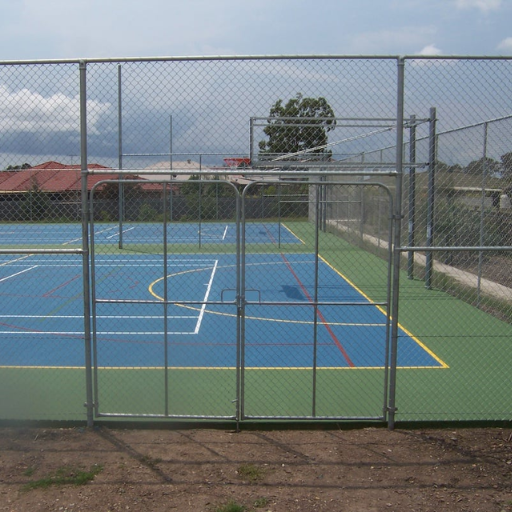
Tennis courts are one of the many sports facilities designed to serve specific purposes such as enhancing privacy, minimizing the effect of wind, and enhancing brand awareness, which can be made more effective through the use of custom-designed windscreens. Sports courts such as tennis and baseball, as well as stadiums, use windscreens to create an ideal environment for the game and spectators, respectively. According to recent industry analysis reports, good quality windscreens can reduce wind speed by up to 50%, allowing you to enjoy good weather even in windy conditions.
Due to their high strength and UV stability, vinyl-coated polyester and polypropylene configurations are the preferred materials, typically lasting 5-7 years or more under the right conditions and climate. In response to the possible means of enhancing dividends through branding, high-quality printed windscreens allow organizations to display logos, sponsor advertisements, and even facility names, thereby increasing a sense of professionalism and consequently generating more revenue. Custom graphics, now with the help of modern printing technology, can be formulated with high level of detail without the danger of being washed out over time.
Likewise, contemporary solutions come with uncomplicated installation and management. Most of these designs come with reinforced edges and firmly held grommets built at a distance of 12-18 inches to provide maximum tension and durability. Wetting wall fabric panels come in a variety of heights and opacities, and can thus be produced to meet the specific requirements of the facility. Results of the latest market studies show that it is possible to augment efficiency in closed sports facilities and increase customer satisfaction by 30% through custom-made windscreen applications.
The correct choice of materials and design aspects can help sport court fencing facilities to extend the best features of the fencing, providing athletes and visitors with a pleasing pedestal.
Designing a Custom Sports Court Fence
When I work on the sport court fencing project, my major concern is durability, usability, and attractiveness. Other factors I consider are the specific sport to be played, the security measures to be implemented, and the outside environment. Selecting premium materials and applying the correct spacing and height helps one ensure safety and durability. Also, I take into account the comfort of the people using the space and not just creating a boring fence that restricts what compliments the facility.
Residential vs. Commercial Fencing Solutions
Parameter | Residential Fencing | Commercial Fencing |
|---|---|---|
Primary Purpose | Privacy, aesthetics, boundary definition | Security, access control, durability |
Common Materials | Wood, vinyl, decorative metal | Steel, chain link, concrete, aluminum |
Height | 4-6 feet | 6-12 feet or more |
Installation | Simpler, quicker | Heavy-duty, reinforced |
Regulations | Fewer restrictions | Strict codes, ADA compliance |
Aesthetics | Focus on charm and curb appeal | Branding, clean lines |
Cost | Affordable upfront | Higher cost, long-term investment |
Maintenance | Regular upkeep (e.g., painting wood) | Minimal, weather-resistant materials |
Durability Considerations for Long-lasting Fencing
When choosing the appropriate solutions for placing the fences, the characteristic of endurance should always be factored in to avoid changes of the fencing due to ageing, which would then compromise the safety and value of the fencing. In View of the Above, here are Five Things to give in detail when looking for a Fencing Solution for a Long Period of Time.
Quality of the Material in Use
Choose corrosion-resistant materials, such as galvanized steel, aluminum, and pressure-treated wood. For instance, a galvanized steel fence will last for over twenty years with little care, while a wood fence treated against pressure does not encourage the accumulation of termites and rot.
Climatic Conditions
Use materials that are specifically made to withstand the weather in the particular area. For instance, vinyl fencing can endure most moisture and sun rays without any problems for a long time. In contrast, a metal fence that our client would choose powder coat would be easy to maintain around South African beaches as it would add resistance to corrosion.
Maintenance
The types of materials used to construct the sport court fencing determine how it should be maintained.
Implement a systematic maintenance schedule which could include cleaning, sealing, and painting when necessary. According to research, routine maintenance of wooden fences increases their lifespan by half as compared to those that are left untouched.
Best Practices in the Construction of Fences
Make sure to have the fence installed correctly to avoid cases of structural failure. For example, encasing fence posts with concrete and using non-corrosive fixings enhance fence stability and longevity. Otherwise, the fence may develop some bends or lean over time due to improper installation.
Types of Protective Finishes
Apply protective finishes to the construction materials to retain their usefulness with time. For instance, wooden fences can be well preserved by finishing with protective sealants, and a powder coat is a great addition to metallic objects, helping them resist most environmental effects and effectively lowering the rate of wear and tear.
All these measures are important for increasing the durability of any fencing material; hence, regular replacements of fencing do not occur, saving the costs incurred in doing so.
Installation and Maintenance of Court Fences
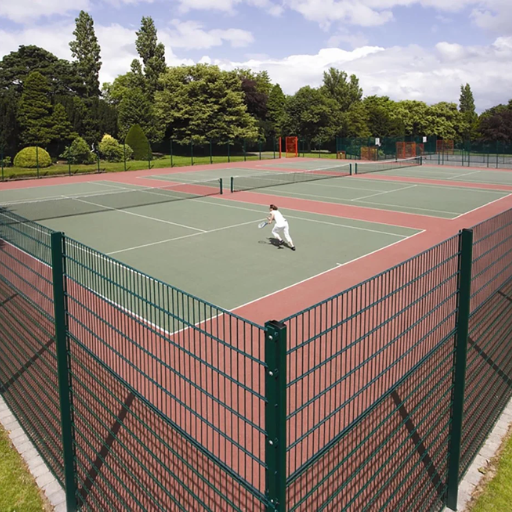
The best way to ensure sport court fencing lasts long while serving its intended purpose is proper construction and resting of the facings. The following 5 tips should be taken into consideration for best results:
Having a Solid Foundation
For it to stand, it must have a solid base. All the fence poles should be straight in to the ground up to at least two to three feet and concrete used to stiffen them. This way, there is no swaying due to the expansions' closed structures from the wind and the earth as they reposition naturally.
Ensuring Best Quality Materials are used
Using suitable materials like galvanized steel or strong mesh ensures the fence can endure heavy demand and extreme weather conditions. The use of non-corrosive material extends the life of the building.
Ensuring Proper Tensioning
The fence fabric should be installed under tension; its installation is necessary so that it does not sag on its own or allow gaps. Sports chain link fencing is one such type of fencing that requires this step as it is primarily used for security and aesthetic reasons.
Conducting Timely Monitoring
Plan on I inspected the equipment periodically so that any warning signs, such as corrosion, bolts missing or any breakage can be easily noticed. Immediately applying the fixes helps avoid costly or risky repairs.
Maintenance Cleaning
Part of the regular maintenance is washing the fences surrounding the courts of the field because they tend to get dusty, dirty and there is debris shover them. You can also power wash or use gentle soaps to clean the fence to preserve its appearance and minimize environmental damage.
In doing so, such fences provide all of these facilities for a long time and are pleasing to look at, making the court users feel comfortable.
Steps for Installing a Sports Court Fence
Step | Key Points |
|---|---|
1. Plan Fence Layout | Measure and mark corners and post locations. |
2. Prepare Post Holes | Dig holes and ensure proper depth and spacing. |
3. Install Fence Posts | Use concrete to secure posts in place. |
4. Attach Fence Panels | Fix panels to posts with brackets or clamps. |
5. Add Gates | Install gates at strategic, accessible points. |
6. Consider Court Slope | Adjust post heights for sloped surfaces. |
7. Ensure Wind Control | Use lightweight materials for air circulation. |
8. Final Adjustments | Check alignment and tighten all fittings. |
Maintenance Tips for Longevity
It is vital to take care of the sport court fencing in use for a long time to come. Here are five useful ways that can help you increase the lifespan of your fence:
Follow the Inspection Routine
Have monthly inspection routines to check for any type of damage, such as loose bolts, rust, broken parts, among other things. Prevention is better than cure, and in this case, it avoids costly repairs.
Keep Away Rust
Every time, coat the metal parts with an anti-rust material to avoid any corrosion. If rust is already present, a mild sanding followed by rust-inhibiting paint or coating should be done.
Test the Tension
Check all types of fencing materials like chain link fencing and mesh material to ensure that they are held tightly in position. This avoids the risks of having sagging fences which bring safety issues, especially during games or bad weathers.
Clean Out Debris
Clear any leaves, dirt and debris from the bottom of the fence regularly. Debris buildup tends to conceal moisture, leading to corrosion, or allowing mold to grow with time.
Seasonal Considerations
Make sure the fence is ready for every season. For example, during the winter, check for frost damage and clear any snow that might have piled up. In the summer, look for sun damage and reapply paint whenever necessary.
Using these maintenance practices would help to prolong the use of a sport court fencing without letting it deteriorate or lose its appeal.
Choosing Professional Installation vs. DIY
Parameter | Professional Installation | DIY Installation |
|---|---|---|
Cost | Higher upfront cost | Lower initial cost |
Expertise | Skilled professionals ensure quality | Requires personal construction skills |
Time | Faster completion with minimal effort | Time-intensive and labor-heavy |
Permits & Compliance | Handled by professionals | DIYers must research and manage permits |
Warranty | Often includes warranties | Limited or no warranty |
Customization | Access to advanced designs and materials | Limited to available DIY options |
Risk of Errors | Low, due to professional experience | Higher, especially for complex projects |
Long-Term Value | Durable, high-quality installation | Potential for costly future repairs |
Flexibility | Limited to contractor schedules | Work at your own pace |
Safety | Ensures proper safety measures | Risk of improper installation |
Frequently Asked Questions (FAQ)
What advantages result from the construction of a sport court fence?
A sport court fence is a suitable solution that keeps the ball within the specific court, prevents potential disturbances, and ensures players’ safety during the game, among other benefits. Besides, it may significantly enhance the appearance of your sport complex because the enclosure is usually very stylish and blends well with the environment.
Where does backyard sport court fencing differ from commercial fencing?
Each type of sport court fencing for the backyard, in most cases, is aesthetically pleasing and easy to install in the residential area. Conversely, commercial sport court fencing is primarily focused on preventing wear and tear and fitting multiple users. Commercial fences may be constructed using thicker materials and are usually tailored to suit the requirements of the different sporting arenas.
Which netting systems are used for decathlon courts?
There are few good netting systems for sports courts. Other than barrier netting to keep the ball inside, there are also training-enhancing rebounder nets. These systems are meant to be versatile, weather-resistant, and safe for use.
How do I prolong the lifespan of sports court fencing?
The secret to making sport court fencing last longer is to use more expensive materials, such as mesh or chain link, which are designed for outdoor use. You can also extend the life of the fence without losing its effectiveness by undergoing such activities as cleaning, clearing, and repair, among others.
How does one install a sport court boundary and the accompanying fence?
Setting up a sports court fence generally includes evaluating the length and breadth, using the right construction supplies, and fastening the poles in the soil. Most of the fences are also made in the DIY style; and allow for easy installation of the backyard features by the client.
Will I Have Options for Customizable Sport Court Fencing?
Yes, you will find that several manufacturers offer sport court fencing that can be modified to suit their clients, and all other necessary work will be done for you. Height, structure, coloring, and even styling may all be altered to make the fencing visually and functionally appropriate.
Which sports usually necessitate a surrounding fence around the courts?
Court fencing is needed for many sports such as basketball, soccer, tennis and even pickleball. They create an area where balls are not easily lost, ensuring the safety of athletes during practice and competitions.
Why is sport court fencing important for entertainment purposes?
With a sport court fencing, only the possibility of playing games in a certain area filled with rules as well as players is eliminated. The players are more immersed and concentrated, and hence cannot be refrained from engaging in the game due to any distractions or losing the ball out of their area. This backing of the game enhances the spirit of ‘fun’, marking it as suitable for backyard purposes or events, including sports activities.
Tags: sport court fencing
